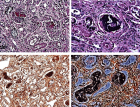Abstract
Research Article
Effects of Site Factors on the Clonal Growth of Phyllostachys bambusoides f. shouzhu Yi
Xiaohong Gan*, Lijuan Chen, Cuibin Tang and Xia Zhang
Published: 25 September, 2017 | Volume 1 - Issue 2 | Pages: 071-079
In order to provide theoretical foundation for forestation of Phyllostachys bambusoides f. shouzhu Yi, the site factors, and the morphological character and biomass of standard bamboo were investigated in 16 sample spots of bamboo forest in Liangping county, Chongqing City, and then the effects of site factors on the clonal growth was discussed. Three site factors as the slope position, altitude, species diversity, had significant effects on the clonal growth of the bamboo. The effects of the gradient, slope aspect, humus thickness, and soil thickness were little, but that of slope aspects was not significant. The altitude of above 800 m, the upper slope, the steep slope and slope, and the thin soil were not suitable for its clonal growth. The results showed that (1) the main site factors affecting the growth of P. bambusoides f. shouzhu were slope position, soil thickness and humus thickness; (2) The forestation site of P. bambusoides f. shouzhu should be selected at the flat ground and the gentle slope of the hills below altitude of 800 m, and the slope position of the forestation site should be selected at the mid and lower position of a hill; (3) Soil thickness and humus thickness should be kept at a suitable level; (4) The diversity of plant species in the bamboo forest should be kept at a suitable level for keeping its growth environment.
Read Full Article HTML DOI: 10.29328/journal.jpsp.1001009 Cite this Article Read Full Article PDF
Keywords:
Phyllostachys bambusoides f. shouzhu Yi; Growth; Morphological character; Biomass; Site factors
References
- The Editor Committee of Flora of China, Chinese Academy. Flora of China, Tomus. Science press. 1996; 9: 295.
- Yi TP, Shi JY, Ma LS, Atlas of bamboo in China. Science press. 2008; 320.
- Qi HR. Rejuvenation after blossom of ‘Shouzhu’ forest. Bamboo Research. 1989; 2: 60-63.
- Noguchi M, Yoshida T. Factors influencing the distribution of two co-occurring dwarf bamboo species (Sasa kurilensis and S. senanensis) in a conifer-broadleaved mixed stand in northern Hokkaido. Ecological Research. 2005; 20: 25-30. Ref.: https://goo.gl/AEAdkP
- Suzaki T, Kume A, Ino Y. Effects of slope and canopy trees on light conditions and biomass of dwarf bamboo under a coppice canopy. Jpn J for Res. 2005; 10: 151-156. Ref.: https://goo.gl/Cp3832
- Gou GQ, Ding YL. Effect of site factors on clonal growth of Bambusa pervariabilis×Dendrocalamopsis daii in north Guizhou Mountain. Journal of Nanjing Forestry University Nature Science. 2007; 31: 21-24.
- Gou GQ, Ding YL. Effect of site factors on the spatial expansion of bamboo nutrition in Bambusa pervariabilis×Dendrocalamopsis daii. Bamboo Research. 2007; 26: 33-35.
- Duan CX, Dong WY, Liu SC. Study on the relationship between the growth of Neosinocalamus affinis clonal population and site condition in Kunming region. China Forestry Science and Technology. 2008; 22: 42-44.
- Lu SB, Rao W, Peng JS. Effect of site sonditions on biomass of Phyllostachys heterocycla var. pubescens. Journal of Zhejiang Forest Science and Technology. 2008; 28: 22-24.
- Wang YJ, Tao JP, Zhong ZC. Factors influencing the distribution and growth of dwarf bamboo, Fargesia nitida, in a subalpine forest in Wolong Nature Reserve, southwest China. Ecological Research. 2009; 24: 1013-1021. Ref.: https://goo.gl/7jxyvZ
- Hong W, Zheng YS, Chen LG. Study of branch and leaf biomass model in Phyllostachys edulis. Forestry Science. 1998; 34: 11-15.
- Wang Y. Advance in growth and variation of bamboo culm form. Bamboo Research. 2001; 20: 28-32.
- Jin AW, Zhou GM, Ma Y, Zhao Xiawei, Wang Anguo. Studies on biomass of various organ of Phyllostachys praecox. Journal of Zhejiang Forest Science and Technology. 1999; 19: 7-8. Ref.: https://goo.gl/LULN9p
- Wen ZB, Huang ZF, Ding HY. Effective cultivation technology for high yielding Phyllostachys bambusoides. World Bamboo and Rattan. 2008; 6: 30-31. Ref.: https://goo.gl/SFutvc
- Su WH, Gu XP, Guan FY. Biomass structure and its regression models of Bambusa wenchouensis population. Journal of Nanjing Forestry University: Natural Sciences Edition. 2006; 30: 51-54.
- Pu XL. Studies on the biological characteristics of Dendrocalamus sinicus. Doctoral dissertation of Nanjing Forestry University. 2003.
- Chen DG, Li CH. Research into relationship between site factors and soil fertility conditions. Journal of Fujian College of Forestry. 1996; 16: 261-263. Ref.: https://goo.gl/uxZD1P
- Kutiel P. Slope aspect effect on soil and vegetation in a Mediterranean ecosystem. Israel Journal of Botany. 1992; 41: 243-250. Ref.: https://goo.gl/Fc8NuR
- Sternberg M, Shoshany M. Influence of slope aspect on Mediterranean woody formations: Comparison of a semiarid and an arid site in Israel. Ecological Research. 2001; 16: 335-345. Ref.: https://goo.gl/eNQoCJ
- Klemmedson JO, Wienhold BJ. Aspect and species influences on nitrogen and phosphorus in Arizona chaparral soil-plant system. Arid Soil Research and Rehabilitation. 1992; 6: 105-116. Ref.: https://goo.gl/GjATbt
- Olivero AM, Hix DM. Influence of slope aspect and stand age on ground flora of southeastern Ohio forest ecosystems. Plant Ecology. 1998; 139: 177-187. Ref.: https://goo.gl/epxd3H
- Kutiel P, Lavee H. Effect of slope aspect on soil and vegetation properties along an aridity transect. Israel Journal of Plant Sciences. 1999; 47: 169-178. Ref.: https://goo.gl/HGr9kP
- Bian M. Mapping the distribution and biomass of bamboo in the forest under-storey of Qinling mountains, a remote sensing approach. International institute for GEO-information science and earth observation enschede the natherlands. 2006; 22-26. Ref.: https://goo.gl/PqQJXE
- He YL. The relationship between undergrowth vegetation development and soil nutrients in different Phyllostachys edulis forest. Doctoral dissertation of China Forestry Science Academy. 2000.
- Yang CD, Jiao RZ, Tu XN. The development of undergrowth vegetation is an important way to recover the soil nutrient of Cunninghamia lanceolata plantation. Forestry Science. 1995; 31: 276-283.
Similar Articles
-
Impact of Calcium Phosphate Nanoparticles on Rice PlantHrishikesh Upadhyaya*,Lutfa Begum,Bishal Dey,P K Nath,S K Panda. Impact of Calcium Phosphate Nanoparticles on Rice Plant. . 2017 doi: 10.29328/journal.jpsp.1001001; 1: 001-010
-
Antagonistic features displayed by Plant Growth Promoting Rhizobacteria (PGPR): A ReviewMohsin Tariq*,Muhammad Noman,Temoor Ahmed,Amir Hameed,Natasha Manzoor,Marriam Zafar. Antagonistic features displayed by Plant Growth Promoting Rhizobacteria (PGPR): A Review . . 2017 doi: 10.29328/journal.jpsp.1001004; 1: 038-043
-
Physiological impact of Zinc nanoparticle on germination of rice (Oryza sativa L) seedUpadhyaya H*,Roy H,Shome S,Tewari S,Bhattacharya MK,Panda SK. Physiological impact of Zinc nanoparticle on germination of rice (Oryza sativa L) seed . . 2017 doi: 10.29328/journal.jpsp.1001008; 1: 062-070
-
Effects of Site Factors on the Clonal Growth of Phyllostachys bambusoides f. shouzhu YiXiaohong Gan*,Lijuan Chen,Cuibin Tang,Xia Zhang. Effects of Site Factors on the Clonal Growth of Phyllostachys bambusoides f. shouzhu Yi. . 2017 doi: 10.29328/journal.jpsp.1001009; 1: 071-079
-
Common transcriptional regulation of ABA and ethyleneRavi Valluru*. Common transcriptional regulation of ABA and ethylene. . 2018 doi: 10.29328/journal.jpsp.1001013; 2: 001-005
-
Role of HECT ubiquitin protein ligases in Arabidopsis thalianaYing Miao*,Wei Lan,Weibo Ma. Role of HECT ubiquitin protein ligases in Arabidopsis thaliana. . 2018 doi: 10.29328/journal.jpsp.1001016; 2: 020-030
-
Detection of Clavibacter michiganensis subsp. michiganensis in tomato and chili seeds and farming area of Sinaloa, MexicoRuiz Alvarado Cristina*,Soto Ortiz Roberto,Cervantes Diaz Lourdes,Nuñez Ramirez Fidel,Celaya-Michel Hernán,Rueda Puente Edgar O. Detection of Clavibacter michiganensis subsp. michiganensis in tomato and chili seeds and farming area of Sinaloa, Mexico. . 2018 doi: 10.29328/journal.jpsp.1001019; 2: 044-054
-
Bacillus amyloliquefaciens as a plant growth promoting bacteria with the interaction with of grass salt Distichlis palmeri (Vasey) under field conditions, in desert of Sonora, MexicoRueda Puente Edgar O*,Ruiz Alvarado Cristina,Jesús Borboa Flores,Victor Cardenas Salazar,Soto Ortiz Roberto,Lourdes Díaz Cervantes. Bacillus amyloliquefaciens as a plant growth promoting bacteria with the interaction with of grass salt Distichlis palmeri (Vasey) under field conditions, in desert of Sonora, Mexico. . 2018 doi: 10.29328/journal.jpsp.1001021; 2: 059-067
-
Use of essential oils as new food preservatives (Case: Eucalyptus grandis and Eucalyptus crebra)Sendanyoye Marcel*. Use of essential oils as new food preservatives (Case: Eucalyptus grandis and Eucalyptus crebra). . 2018 doi: 10.29328/journal.jpsp.1001023; 2: 083-090
-
Isolation and biochemical characterization of Plant Growth Promoting (PGP) bacteria colonizing the rhizosphere of Tef crop during the seedling stageZerihun Tsegaye*,Birhanu Gizaw,Genene Tefera,Adey Feleke,Solomon Chaniyalew,Tesfaye Alemu,Fasil Assefa . Isolation and biochemical characterization of Plant Growth Promoting (PGP) bacteria colonizing the rhizosphere of Tef crop during the seedling stage. . 2019 doi: 10.29328/journal.jpsp.1001027; 3: 013-027
Recently Viewed
-
Pneumothorax as Complication of CT Guided Lung Biopsy: Frequency, Severity and Assessment of Risk FactorsGaurav Raj*,Neha Kumari,Neha Singh,Kaustubh Gupta,Anurag Gupta,Pradyuman Singh,Hemant Gupta. Pneumothorax as Complication of CT Guided Lung Biopsy: Frequency, Severity and Assessment of Risk Factors. J Radiol Oncol. 2025: doi: 10.29328/journal.jro.1001075; 9: 012-016
-
The Police Power of the National Health Surveillance Agency – ANVISADimas Augusto da Silva*,Rafaela Marinho da Silva. The Police Power of the National Health Surveillance Agency – ANVISA. Arch Cancer Sci Ther. 2024: doi: 10.29328/journal.acst.1001046; 8: 063-076
-
A Comparative Study of Serum Sodium and Potassium Levels across the Three Trimesters of PregnancyOtoikhila OC and Seriki SA*. A Comparative Study of Serum Sodium and Potassium Levels across the Three Trimesters of Pregnancy. Clin J Obstet Gynecol. 2023: doi: 10.29328/journal.cjog.1001137; 6: 108-116
-
Chaos to Cosmos: Quantum Whispers and the Cosmic GenesisOwais Farooq*,Romana Zahoor*. Chaos to Cosmos: Quantum Whispers and the Cosmic Genesis. Int J Phys Res Appl. 2025: doi: 10.29328/journal.ijpra.1001107; 8: 017-023
-
Phytochemical Compounds and the Antifungal Activity of Centaurium pulchellum Ethanol Extracts in IraqNoor Jawad Khadhum, Neepal Imtair Al-Garaawi*, Antethar Jabbar Al-Edani. Phytochemical Compounds and the Antifungal Activity of Centaurium pulchellum Ethanol Extracts in Iraq. J Plant Sci Phytopathol. 2024: doi: 10.29328/journal.jpsp.1001137; 8: 079-083
Most Viewed
-
Evaluation of Biostimulants Based on Recovered Protein Hydrolysates from Animal By-products as Plant Growth EnhancersH Pérez-Aguilar*, M Lacruz-Asaro, F Arán-Ais. Evaluation of Biostimulants Based on Recovered Protein Hydrolysates from Animal By-products as Plant Growth Enhancers. J Plant Sci Phytopathol. 2023 doi: 10.29328/journal.jpsp.1001104; 7: 042-047
-
Sinonasal Myxoma Extending into the Orbit in a 4-Year Old: A Case PresentationJulian A Purrinos*, Ramzi Younis. Sinonasal Myxoma Extending into the Orbit in a 4-Year Old: A Case Presentation. Arch Case Rep. 2024 doi: 10.29328/journal.acr.1001099; 8: 075-077
-
Feasibility study of magnetic sensing for detecting single-neuron action potentialsDenis Tonini,Kai Wu,Renata Saha,Jian-Ping Wang*. Feasibility study of magnetic sensing for detecting single-neuron action potentials. Ann Biomed Sci Eng. 2022 doi: 10.29328/journal.abse.1001018; 6: 019-029
-
Pediatric Dysgerminoma: Unveiling a Rare Ovarian TumorFaten Limaiem*, Khalil Saffar, Ahmed Halouani. Pediatric Dysgerminoma: Unveiling a Rare Ovarian Tumor. Arch Case Rep. 2024 doi: 10.29328/journal.acr.1001087; 8: 010-013
-
Physical activity can change the physiological and psychological circumstances during COVID-19 pandemic: A narrative reviewKhashayar Maroufi*. Physical activity can change the physiological and psychological circumstances during COVID-19 pandemic: A narrative review. J Sports Med Ther. 2021 doi: 10.29328/journal.jsmt.1001051; 6: 001-007

HSPI: We're glad you're here. Please click "create a new Query" if you are a new visitor to our website and need further information from us.
If you are already a member of our network and need to keep track of any developments regarding a question you have already submitted, click "take me to my Query."
























































































































































